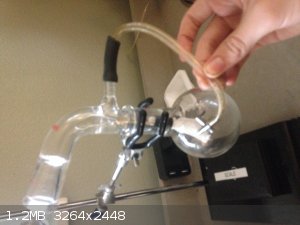Abromination
Hazard to Others
  
Posts: 432
Registered: 10-7-2018
Location: Alaska
Member Is Offline
Mood: 1,4 tar
|
|
Improvised Vacuum Desiccator
All of my glassware is specifically for vacuum distilation, so I decided to make myself a desiccator. Its fairly simple: the sample that you want to
dry hangs in a piece of filter paper over a desiccant. The paper is attatched to a vacuum take of side arm and is placed over the desiccant in a round
bottomed flask. A valve is attached to the vacuum take of and a vacuum is pulled on the apparatus. While the pump is still on, he valve is closed.
When the pump is turned off the glass still holds a decent vacuum. I'll include a picture, although I won't load it with desiccant.

List of materials made by ScienceMadness.org users:
https://docs.google.com/spreadsheets/d/1nmJ8uq-h4IkXPxD5svnT...
--------------------------------
Elements Collected: H, Li, B, C, N, O, Mg, Al, Si, P, S, Fe, Ni, Cu, Zn, Ag, I, Au, Pb, Bi, Am
Last Acquired: B
Next: Na
-------------- |
|
|
Refinery
Hazard to Others
  
Posts: 371
Registered: 17-2-2014
Member Is Offline
Mood: Still
|
|
Basically you could attach two vessels, place they dryee and dryant on their own and evacuate the vessel. The most easily available solution for this
would be an ordinary distillation set. The dryee can easily be heated as well by just placing it in warm water bath or other heat source. Removing the
anhydrite from rbf can be a task, though.
A valve for enclosure, and good glass joints and/or joint grease would be in order for the system to hold the passive vacuum.
|
|
|
|